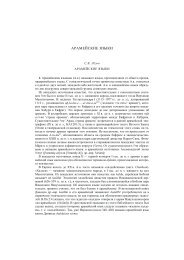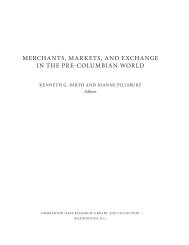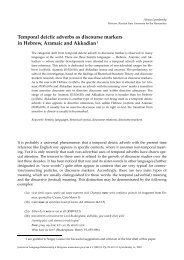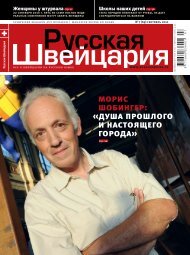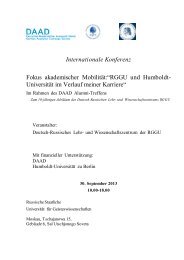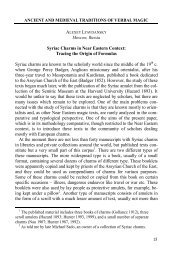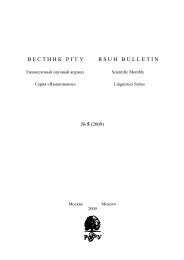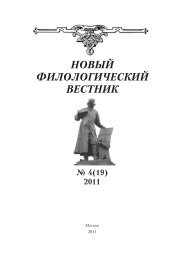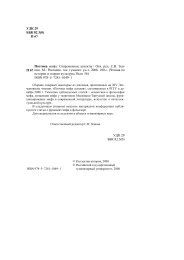Akkadian Sentences about the Present Time (II/2)
Akkadian Sentences about the Present Time (II/2)
Akkadian Sentences about the Present Time (II/2)
You also want an ePaper? Increase the reach of your titles
YUMPU automatically turns print PDFs into web optimized ePapers that Google loves.
768 Morphosyntax and Text Structure in <strong>Akkadian</strong>new meaning developed its own prefixing tenses: ¢uppi bēlīya ú-la-ap-pítam‘<strong>the</strong> tablet of my lord was late (arriving) here’ (ARM 2, 106:14).The VA lupputu (SB ‘damaged, soiled’) also developed its own SC ‘tobe anomalous (said of ominous features)’ (CAD L 91): bēlī īde kīma têrētumlu-up-pu-ta ‘my lord knows that <strong>the</strong> extispicies are anomalous’ (ARM 10,87:9).(42) lawûm ‘to move in a circle, to surround’In OB, <strong>the</strong> Pres. is hardly ever used to express contemporaneity with areference point. Kouwenberg counts lawûm among verbs that “have anactive stative with more or less lexicalized meanings”: lawû ‘to lay siegeto,’ Stat. ‘to besiege’ (i. e., ‘to lie around (a city)’; Kouwenberg forthcoming7.3.2). In OB letters, <strong>the</strong> SC seems to be productive in both P and Atrans. readings: ālum GN la-wi (ARM 6, 65:8), dūrum šulêm la-wi ‘<strong>the</strong> wallis surrounded by an outer wall’ (ARM 6, 29:16), inanna bēlšu ištu 3 MU lawi-ma‘and now his lord has been under siege for three years (and still hehas not come)’ (ShT, p. 79:59f.), ālam GN ša PN la-wu-ú PN i´´abat ‘<strong>the</strong>town GN that Išme-Dagan was besieging Išme-Dagan has captured’(ARM 1, 4:5–8). A similar usage is well attested in divination apodoses,e. g. āl la-wi-at ana libbi-šu terrub ‘you will enter <strong>the</strong> city which you are besieging’(RA 27, 142:2). In OB divination protases, <strong>the</strong> SC is attested inwhat appears to be an intrans. non-passive sense: šumma qut[rinnum]alākšu ana [imittim] la-wi … šumma qutrinnum alākšu ana šumēlim la-wi ‘if <strong>the</strong>drifting smoke circles to <strong>the</strong> right …’ (PBS 1/2, 99 ii 1–7, transl. as inCAD L 70). This token of <strong>the</strong> SC looks like a fientive one. 22 P tokens of<strong>the</strong> SC are frequent in OB divination protases, e. g. DIŠ ur!udum šēram lawi‘if <strong>the</strong> trachea is surrounded with flesh’ (YOS, 10 36 iv 21). In OA, Iwas able to find only <strong>the</strong> Imv. and <strong>the</strong> Proh. of this verb, with <strong>the</strong> transitivemeaning ‘to wrap’ (CAD L 75b, Prag I 718:22).VA lawûm ‘besieged; fenced.’(43) leqûm ‘to take’In OB letters, <strong>the</strong> SC A is common. It is routinely used to render <strong>the</strong> notion‘X (has) received something’, often a specified amount of barley orsilver: 97 ŠE.GUR ana 80 ŠE.GUR ša elīya taršû le-qí-a-ti ‘You have received97 kor of barley for <strong>the</strong> 80 kor of barley that you held against me’ (AbB 9,105:15ff.), ištu annikīam kaliāku 3 GÍN KÙ.BABBAR ana šamaššammī ana ¢ātim22Yet, cf. šumma qutrinnum alākšu ´alim ‘if <strong>the</strong> smoke’s trail is black’ (PBS 1/2, 99 i 17).




